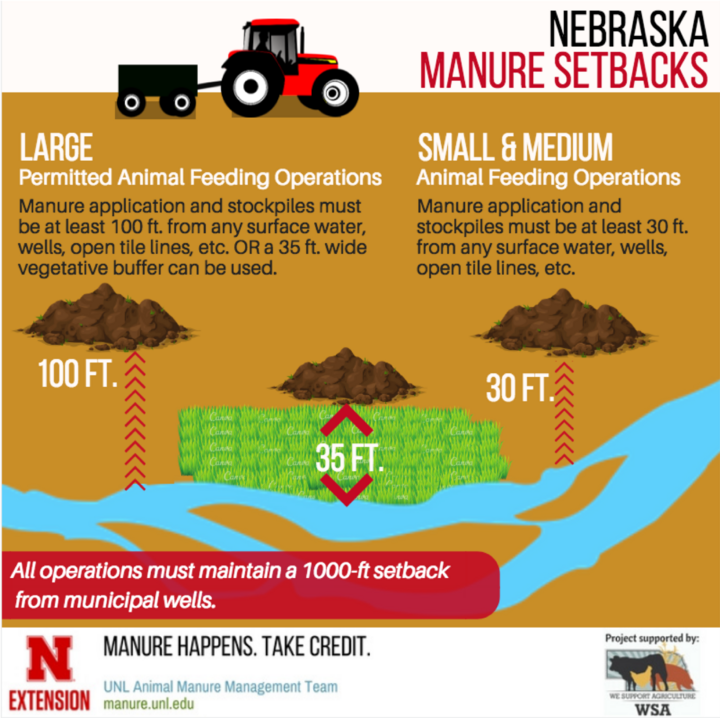Livestock Waste Regulations in Nebraska are enforced by the Nebraska Department of Environment and Energy (NDEE). NDEE administers both state and federal (EPA) environmental regulations. The governing regulations are called Title 130, Livestock Waste Control Regulations. The entire Title 130 document is contained on the NDEE Website, and Nebraska Extension has summarized the relevant rules pertaining to manure management for livestock producers. The video in this section discusses the history of the regulations and what is required of livestock operations in Nebraska.
There are two methods for determining land application rates in nutrient management plans. These methods are explained in depth in the video. Manure transfers are also addressed. Manure can be transferred off the livestock operation legally, but one must take care to have the proper records in place in order to have a legitimate manure transfer.

Common Regulatory Questions
Setbacks must be observed when land applying manure in Nebraska.
Setbacks
Large Concentrated Animal Feeding Operations
Chapter 9 of title 130 currently states that Large CAFOs may not apply manure within 100 feet of any surface water or conduits to water unless one of the alternatives is met. Alternatives include an established 35 foot vegetated buffer between the manure application area and water. If someone can demonstrate that pollutant reductions are equal or better than the 100 foot setback, other options may be used, but must be approved by the NDEE prior to application.
Small and Medium Concentrated Animal Feeding Operations
For small and medium CAFOs, a 30 foot setback must be observed around all water sources.
One exception to these rules is the setback distance around municipal wells, which is 1000 feet regardless of the size of the operation.
Stockpiles
Stockpiles should be located in a manner to prevent contamination of water. Look for sites that meet all setbacks and are:
- as remote from lakes, streams, or intermittent water flows as possible
- remote from ditches, grassed waterways, and tile inlets
- on flat areas where runoff risk is minimal
- on grassed or pasture areas so the pile can be surrounded by permanent vegetation.
If runoff risk is high, diking around piles may be required. A two to three (2-3) foot dike constructed of soil (not manure or other organic materials), particularly on the down-gradient side of the pile, is recommended.
Inspections
Inspections of animal feeding operations are to occur regularly for existing permitted operations. The time between inspections varies and often depends on the problems or lack of problems during previous inspections. If past inspections turned up problems on the operation, the operation is likely to be inspected more often than an operations that has no history of compliance issues. Your NDEE inspector will call ahead (usually several days) to make an appointment to stop in and look over your operation and records. Surprise inspections are not standard procedure. The checklist that a DEE inspector will be using to inspect an operation is available for you to prepare for your inspection ahead of time.
Part I of Regulations | Part II - Recordkeeping | Complete the Quiz